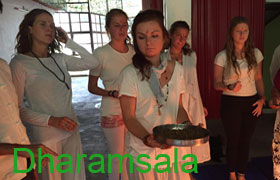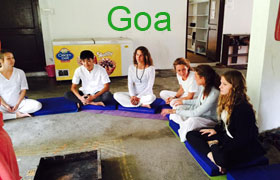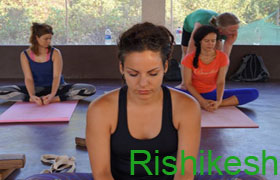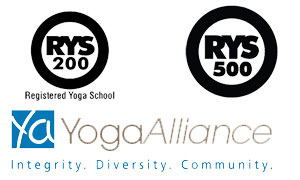Asanas that Strengthen Abdomen (Stomach)
Padmasana
Procedure
1. Sit in dandasana posture.
2. Hold your right leg with both of your hands and fold it and place it over your left lap.
3. Now hold your left leg with both of your hands and fold it and place it over your right lap.
4. Keep both of your hands in Gnyana mudra and place them over your knees. You can either close your eyes our keep your vision straight. You should keep your spinal cord straight.
Benefits
This is an effective asana for meditation. It improves mental peace and concentration.
Precaution
If you have knee pain you should not practice this asana.
Visharam Asana (Upavisht)
This asana involves sitting in a relaxed state. Thus it is called upavisht vishrama asana.
Procedure
1. Sit keeping both of your legs a little distant from each other.
2. Place both of your palms behind your buttocks and roll you head backwards. Also keep your eyes closed.
Benefits
This relieves the body and mind from tiredness.
Ardha Padmasana
Procedure
1. Sit in dandasana posture. Keep your body and legs straight. Place your palms on the floor near your buttocks.
2. Slowly fold your right leg and place it over your left thigh.
3. Now fold your left thigh and place it under your right thigh.
4. Keep both of your hands on your knees and concentrate your vision on the tip of your nose.
Benefits
1. This asana controls the high blood pressure.
2. It makes the mind peaceful and relieves it from tension.
3. Relaxes the endocrine glands.
Precautions
This asana should not be practiced if you have pain in your back or knees.
Our yoga teacher training program in Rishikesh starts with these basic asanas and train you to become an expert in advanced levels.
Vakrasana
Procedure
1. Keep both of your legs straight and also keep your body straight. Place your palms on the floor near your buttocks.
2. Fold your right leg and place it near your left knee. Right ankle and left knee should be together.
3. Raise your left hand and place your right knee on the other side.
4. Place your right hand 6 inches away behind your buttocks.
5. Turn your head backwards and look towards your right shoulder.
6. Pause in this posture for a while and revert to the original state slowly. Now repeat the same process with the other leg too.
Benefits
1. Helpful for diabetes and liver.
2. Very good for neck.
3. Makes your spinal cord flexible.
4. Improves functionality of your intestines.
5. influences pancreas.
Jaanushira Asana
Procedure
1. Sit in dandasana posture. Bend your left leg and make its ankle touch the root part of your thigh.
2. Inhale air into your chest and raise your hands up and bend forward while exhaling. And hold your toes with your hands and try to make head touch your knees. But don’t do it forcibly.
3. Pause for a while in this posture and revert to the original position while inhaling.
4. Repeat the same procedure with the other leg too.
Benefits
1. This asana is good for knees.
2. It strengthens the muscles of thighs and buttocks.
3. Works well on belly.
4. Improve digestion.
5. It is helpful in kundalini awakening.
6. Influences ovaries, adrenal and pancreatic glands.
Precautions
This asana should not be practiced if you suffer with back ache or neck pain or sciatica.
Vajarsana
The Sanskrit word ‘vajra’ means diamond.The weapon used by Lord Indra is as tough and strong as a diamond. Similalrly, through the practice of this asana, our body becomes as strong as a diamond. Thus it is named as vajrasana.
Procedure
1. Sit in the posture of danda asana. Fold your right leg with the help of your right hand and bring it under your right buttock.
2. Now fold your left leg with the help of your left hand and place it under your left buttock.
3. Toes should be to the inner side while the ankles are outer wards.
4. Place both your hands on your thighs.
5. Keep your body straight. You can keep your eyes closed or look in front.
Benefits
1. This is a meditative posture. Thus it is very helpful for improving concentration and memory.
2. The muscles of the shank and thighs will be strengthened.
3. Improves the digestion capability.
4. Greatly influences pelvic region.
Precautions
This asana should not be practiced if you undergone any operation in knees, ankles or haemorrhoids.
Parvatasana
Procedure
1. Sit in the posture of vajrasana. Fold your hands in namaskaar mudra. Gradually raise your hands upwards while inhaling and stretch your hands.
2. Pause in this posture for a while. Then slowly exhale and revert to namaskaar mudra. Then place your hands on your thighs and sit in vajrasana. Parvatsana can be practiced in padamasana too.
Benefits
1. Highly beneficial for asthma, shoulders, and neck.
2. Very good for back muscles.
Precautions
You should not practice this asana if you feel pain in your heart.
Our yoga teacher training program in India will turn you as an expert yoga trainer of all these asanas.




